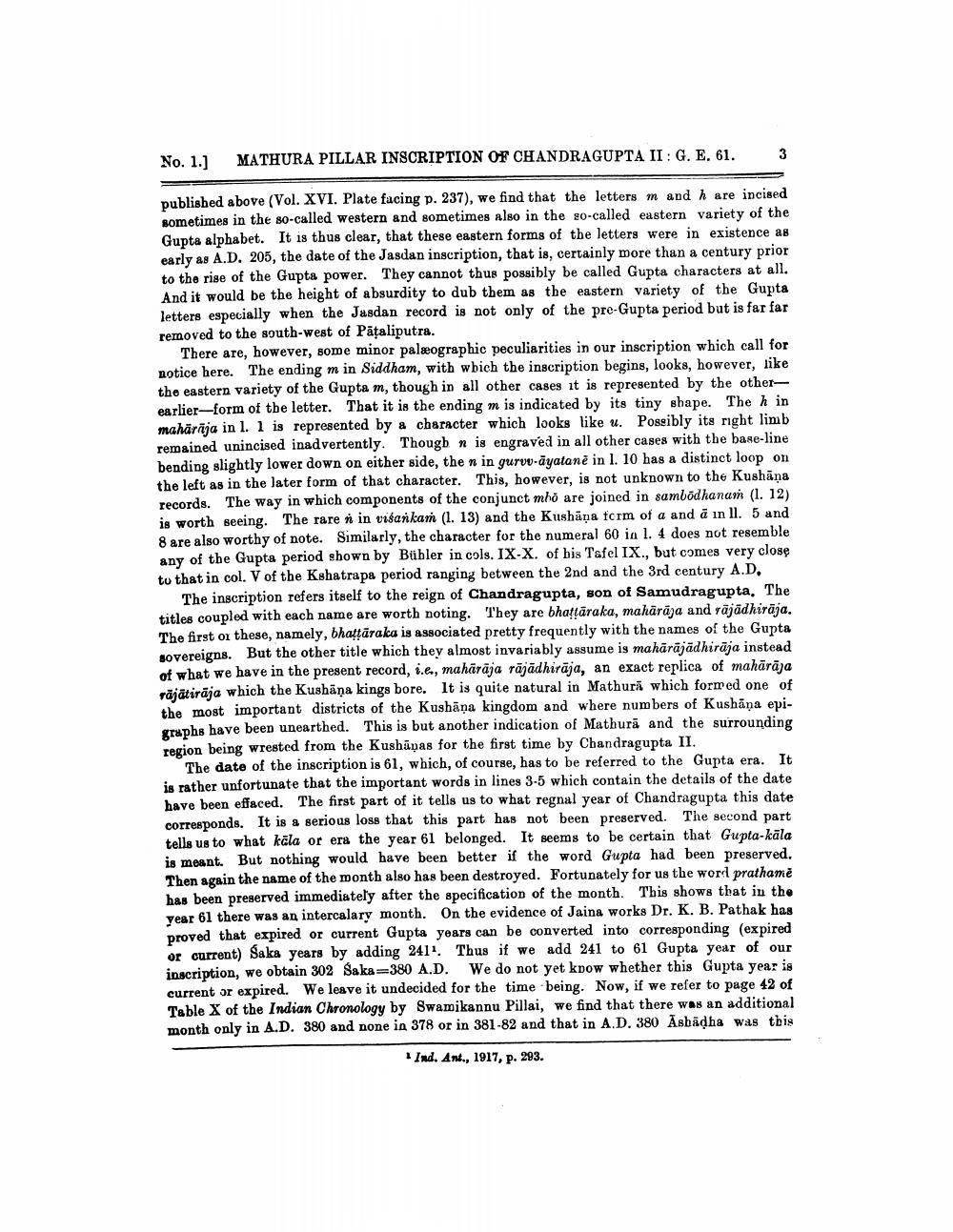________________
No. 1.]
MATHURA PILLAR INSCRIPTION OF CHANDRAGUPTA II: G. E. 61.
3
published above (Vol. XVI. Plate facing p. 237), we find that the letters m and h are incised sometimes in the so-called western and sometimes also in the so-called eastern variety of the Gupta alphabet. It is thus clear, that these eastern forms of the letters were in existence as early as A.D. 205, the date of the Jasdan inscription, that is, certainly more than a century prior to the rise of the Gupta power. They cannot thus possibly be called Gupta characters at all. And it would be the height of absurdity to dub them as the eastern variety of the Gupta letters especially when the Jasdan record is not only of the pre-Gupta period but is far far removed to the south-west of Pataliputra.
There are, however, some minor palæographic peculiarities in our inscription which call for notice here. The ending m in Siddham, with wbich the inscription begins, looks, however, tike the eastern variety of the Gupta m, though in all other cases it is represented by the other earlier-form of the letter. That it is the ending mis indicated by its tiny shape. The h in mahārāja in l. 1 is represented by & character which looks like u. Poseibly its right limb remained unincised inadvertently. Though n is engraved in all other cases with the base-line bending slightly lower down on either side, then in guruv-āyatane in l. 10 has a distinct loop on the left as in the later form of that character. This, however, is not unknown to the Kushāņa records. The way in which components of the conjunct mhó are joined in sambodhanam (1. 12) is worth seeing. The rare n in visankam (1. 13) and the Kushāņa form of a and à in ll. 5 and 8 are also worthy of note. Similarly, the character for the numeral 60 in 1. 4 does not resemble any of the Gupta period shown by Bühler in cols. IX-X. of his Tafel IX., but comes very close to that in col. V of the Kshatrapa period ranging between the 2nd and the 3rd century A.D.
The inscription refers itself to the reign of Chandragupta, son of Samudragupta, The titles coupled with each name are worth noting. They are bhatļāraka, maharaja and räjädhirāja. The first or these, namely, bhattāraka is associated pretty frequently with the names of the Gupta sovereigns. But the other title which they almost invariably assume is mahārājādhirāja instead of what we have in the present record, i.e., mahārāja rājādhirāja, an exact replica of mahārāja rājātirāja which the Kushāņa kings bore. It is quite natural in Mathurā which formed one of the most important districts of the Kushāna kingdom and where numbers of Kushāņa epigraphs have been unearthed. This is but another indication of Mathurā and the surrounding region being wrested from the Kushāṇas for the first time by Chandragupta II.
The date of the inscription is 61, which, of course, has to be referred to the Gupta era. It is rather unfortunate that the important words in lines 3-5 which contain the details of the date have been effaced. The first part of it tells us to what regnal year of Chandragupta this date corresponds. It is a serious loss that this part has not been preserved. The second part tells us to what kala or era the year 61 belonged. It seems to be certain that Gupta-kāla is meant. But nothing would have been better if the word Gupta had been preserved. Then again the name of the month also has been destroyed. Fortunately for us the word prathame has been preserved immediately after the specification of the month. This shows that in the year 61 there was an intercalary month. On the evidence of Jaina works Dr. K. B. Pathak has proved that expired or current Gupta years can be converted into corresponding (expired or current) Saka years by adding 241. Thus if we add 241 to 61 Gupta year of our inscription, we obtain 302 Saka=380 A.D. We do not yet know whether this Gupta year is current or expired. We leave it undecided for the time being. Now, if we refer to page 42 of Table X of the Indian Chronology by Swamikannu Pillai, we find that there was an additional month only in A.D. 380 and none in 378 or in 381-82 and that in A.D. 380 Asbädha was this
Ind. Ant., 1917, p. 293.




